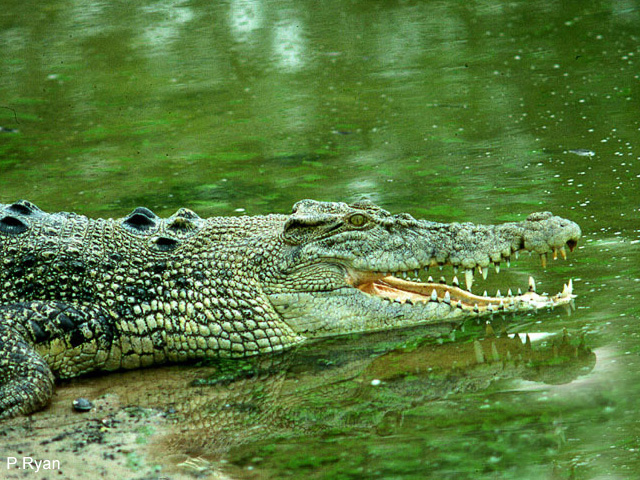| Crocodylidae (true crocodiles) |
| 615 cm TL (male/unsexed) |
|
pelagic; freshwater; marine; depth range 0 - 200 m, oceanodromous |
| Indo-West Pacific. |
|
Large head and strong snout with a pair of ridges bridging the orbits. Uniform dorsal scales. Very variable coloration. Juveniles with black bands and spots. Body with 4-5 black bands which may disappear in very large individuals. The belly is uniformly colored beige to golden yellow. Some individuals maybe highly pigmented. |
| May cross open ocean as evidenced by occurrence in remote islands in the Indian Ocean and in the western Pacific Ocean (salinity range 5-20 per mille). Inhabits a wide range of habitats (rivers, creeks, swamps, lagoons and billabongs); needs a source of water less salty than their blood (blood plasma salinity of 11per mille). Ref. 77096 reports a maximum length of 700 cm total length and a maximum weight of 1000 kg for captive individuals. Often basks on open mud banks in cooler months and often in the shade of mangrove areas in warmer months. Has a strong homing ability. Oceanodromous individuals may have barnacles attached to their scales (Ref. 77096). May also have endoparasites, i.e., round worms, tongue worms and flukes (Ref. 77091). Crocodile eggs and flesh are food for humans, while crocodile skin (notably near the belly) are used by the leather industry mostly from farmed crocodiles (Ref. 77091). Known to attack humans, sometimes fatally (Ref. 077096, 077099). Active throughout the year. Hunts by day and night; hunting probably associated to diving behavior. Size determines feeding, i.e., small crocodiles feed frequently on small prey items while larger crocodiles feed infrequently on larger prey. May consume carrion. Gastroliths (stomach stones) help in digesting food items (Ref. 77091). |
|
(LC); Date assessed: 14 November 2019 Ref. 123251)
|
| traumatogenic |
|
Source and more info: www.sealifebase.org. For personal, classroom, and other internal use only. Not for publication.

